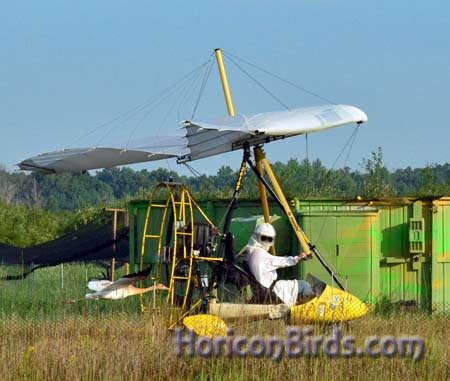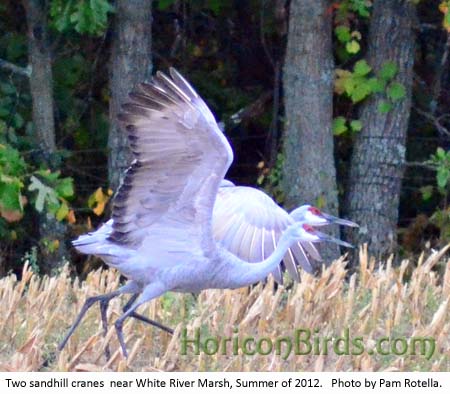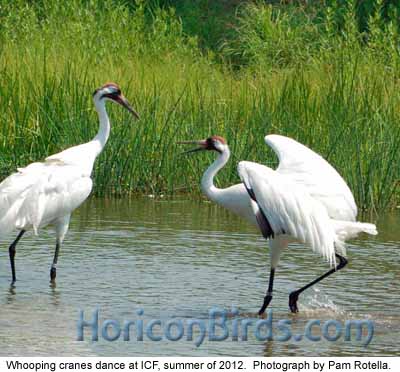|
Duff, Archibald speak at 2012 Whooping Crane Festival
by Pam Rotella
25 September 2012, last updated 7 October 2012
HoriconBirds.com
Hundreds of people packed the Berlin Conservation Club in Berlin, Wisconsin on Saturday for the annual Whooping Crane Festival. The 2012 festival featured a silent auction, information booths, a breakfast to benefit Operation Migration, and a series of speakers including Joe Duff and George Archibald.
Located near White River Marsh, Berlin is a new location for the festival that follows Operation Migration's move of its whooping crane program to the area last year.
Joe Duff, co-founder of Operation Migration
Joe Duff, co-founder and lead pilot of Operation Migration, provided an extensive account of his organization's whooping crane flight training program.
Nearly twenty years earlier, Duff had joined with Bill Lishman to lead then-endangered Canada Geese on migrations using ultra-light aircraft, a technique developed by Lishman. Operation Migration was formed, and after proving the aircraft training technique successful with Canada Geese flocks, their organization started training whooping cranes.
"So, we started working with them [Patuxent Wildlife Research Center], and of course they weren't going to let us work with whooping cranes right away," Duff said.
"You've got to understand, there's two Canadians, you know -- neither one are biologists. One's a metal sculptor, one's a photographer, and we've just asked the US Fish and Wildlife agency if we can take their most endangered species so that we can dress up in a costume and fly an airplane half across the country. That's a tough sell, you know?
"And that, to me, is the most amazing part of this project. Not that the birds can fly -- it's that we could convince the U.S. federal government that it was a good idea!"
According to Duff, as early as a few days after hatching, whooping crane chicks at Patuxent Wildlife Research Center are trained to follow a retired ultra-light aircraft without its wing.
Then, said Duff, "We put the wings on the aircraft eventually, and it takes quite a long time for them to get used to that thing over their heads. We found that if we do it on an overcast day, it works easier because on sunny days we have the wing up here and the shadow down there. When they get trapped in the middle they don't like it very much. We end up feeding them a lot of smelt and grapes, just to get them used to that wing."
Duff described how crane chicks have to be raised separately at first because they naturally want to fight each other. In the wild, even if a nesting pair hatches two chicks, it's not uncommon for only one crane chick to survive.
The famous white "crane" costumes, a technique called "costume rearing" or "isolation rearing," are how they keep human-reared whooping cranes wild, Duff said. When costumed handler-raised birds first see normally dressed humans, the birds are afraid of them.
Crane costumes don't look exactly like adult cranes, and so to accustom the birds to their own species, a "brood model" of a whooping crane is placed in their pen, and an adult whooping crane is kept on the other side of a plastic shield. The shield is used because adult cranes naturally want to feed the chicks. Duff said that over the years, two birds have been removed from the program because they were too tame, but otherwise the costume-rearing technique has proved successful.
 After a summer of training, the birds are ready to learn their migration route. Duff described how wild cranes use thermal winds to travel long distances, but for their first migration, human-reared cranes ride in the wake of ultra-light aircraft and other cranes in their V-formation.
After a summer of training, the birds are ready to learn their migration route. Duff described how wild cranes use thermal winds to travel long distances, but for their first migration, human-reared cranes ride in the wake of ultra-light aircraft and other cranes in their V-formation.
"Of course, we need stopovers along the way. Birds in the wild are soaring birds. Whooping cranes are soaring birds. You know, they'll take off mid-day, they'll find a thermal, and then just ride the thermal like a hawk or an eagle does.
"They may go as high as ten thousand feet, and then they'll just glide to the next thermal, find it, and climb up, and glide. And they can do that all day. They fly for eight hours a day, as long as the sun is shining, producing that heat. And we can't do that. We don't have the fuel capacity. We don't have the bladder capacity. We don't have the range to fly that."
Earlier, Duff explained that the first migration south takes longer than the whooping cranes' return trip because of that range limitation. "So we have to get cool air first thing in the morning. We get but maybe two hours of flying time, which means we can only do about fifty miles at a time, and so we have stops every 50 miles along the way.
"So, in the wild, it's taken us as long as 100 days to get the birds to Florida, and they've made it back in as little as eight days. It's very embarrassing for us."
Duff also expressed gratitude for the generosity of stopover homes while showing pictures of pies that people had baked for them. "You can also see that we certainly take over when we land at somebody's house. They know we're coming, but they have no idea when. They just know it'll be some ungodly hour in the morning, and we're going to fill the backyard full of airplanes and the front yard full of motor homes, and we're going to plug into every outlet they have. We're going to tap into their water. We're going to steal their internet connection. And that property down there that the birds are on that they own -- they can't go there anymore. And they have no idea when we're leaving. It's like the world's worst mother-in-law story.
"But people are so generous, they do it every year. They welcome us with open arms. There are a number of stopover homes here that we're traveling to. ...That's the kind of support we get."
George Archibald, co-founder of the International Crane Foundation
Dr. George Archibald, co-founder of the International Crane Foundation, began with a presentation on his recent trip to Asia and ICF's efforts to restore cranes there, including Demoiselle and Black-necked Cranes.
He also mentioned Russian president Vladimir Putin's recent flight with Siberian Cranes. Russian scientists have been studying American crane reintroduction programs, according to Archibald, but the longer and varied terrain of Siberian Cranes' migration has made a few modifications necessary, for example the addition of amphibious ultra-light aircraft for marshy areas and hang gliders for traversing greater distances.
 Dr. Archibald then turned his attention to Sandhill Cranes, saying "...we think that the crane family actually had its origins in North America, not in Asia or Africa... [W]e think sandhill cranes invaded the other continents subsequent to their origins in North America.
Dr. Archibald then turned his attention to Sandhill Cranes, saying "...we think that the crane family actually had its origins in North America, not in Asia or Africa... [W]e think sandhill cranes invaded the other continents subsequent to their origins in North America.
"But the sandhill crane is the oldest known bird in the fossil record, dating back millions of years... And they are expanding their range every year. They're going further and further into Western Siberia. There are about 100,000 cranes now crossing the Bering Strait, from Alaska, going into Asia."
Discussing the proposed sandhill crane hunt in Wisconsin, Archibald cited extensive sandhill crane studies by Dr. Gary Krapu of the USGS Northern Prairie Wildlife Research Center in Nebraska, who "found that Greater Sandhill Cranes that breed in this area [Wisconsin] are rather rare, and they are taking the brunt of the hunting that occurs around this migration corridor because they [the hunters] now hunt in early autumn before the whooping cranes come down in this area to their wintering grounds. And when the whooping cranes appear, hunting for sandhill cranes is closed. So the Greater Sandhill Cranes are taking the brunt of the hunting, and the prairie Greaters are actually endangered."
Greater Sandhill Cranes are the largest subspecies of Sandhills, and favoring the largest birds in hunts may cause the sandhill population to shift toward smaller subspecies.
Dr. Archibald also showed a map of all subspecies of sandhill cranes, and said that he can tell the difference between greater sandhills from Wisconsin versus greater sandhills from the Rocky Mountains. He said that the Rocky Mountain sandhills are larger, and that it's enough of a difference to consider a separate subspecies.
Archibald noted that while sandhill hunts are unpopular with crane enthusiasts, the hunts are very popular with hunters. "Hunters, of course, look at it from a different point of view. They call it 'rib eye in the sky.'"
 "...And actually, they're hunted in Saskatchewan, Alaska, all through the sandhill flyway except for Nebraska -- all the other states. And especially in Texas -- there are like 15,000 [sandhill cranes] shot every winter in Texas. It's a big industry. You can't hunt with a dog. The whooping crane would put the eyes out of the dog. And so, it's a whole sport unto itself.
"...And actually, they're hunted in Saskatchewan, Alaska, all through the sandhill flyway except for Nebraska -- all the other states. And especially in Texas -- there are like 15,000 [sandhill cranes] shot every winter in Texas. It's a big industry. You can't hunt with a dog. The whooping crane would put the eyes out of the dog. And so, it's a whole sport unto itself.
"...So, the International Crane Foundation is in a very sticky position on crane hunting. If it were to take a radical stand against crane hunting, and mobilize the people of Wisconsin to kill crane hunting, it would only take one irate hunter to do in most of our whooping cranes. And that's a real threat." said Archibald, noting that nine whooping cranes had already been lost to sandhill shootings.
"The proposal in Wisconsin initially was the cranes are creating damage to the corn in the Spring when it's planted, so we have to reduce the population by hunting them in the Fall. Well, actually the damage is done in the Spring. So, the Crane Foundation for a number of years developed a technique to prevent the cranes from eating the corn. And we've discovered a compound that's not dangerous and very cheap, called anthraquinone, can be applied to corn before it's planted. And it's distasteful to the cranes and they will not eat that corn.
"...So, hundreds of farmers in Wisconsin now are putting anthraquinone on their corn before it's planted. And so we helped solve that problem. But there's still people that want to hunt cranes."
Dr. Archibald noted that one of his best friends can't sleep at night during the start of deer hunting season because the high point of his year is getting into a deer stand. "And I understand that their value system is different from mine. And theirs isn't wrong and mine's not wrong -- but we have very different value systems. So the [International] Crane Foundation has taken a neutral stand on hunting, saying that we have to treat it scientifically."
Pat Fisher, founder of The Feather Rehabilitation Center
 Pat Fisher of The Feather Rehabilitation Center warmed up the crowd with live birds as the first speaker of the 2012 Whooping Crane Festival.
Pat Fisher of The Feather Rehabilitation Center warmed up the crowd with live birds as the first speaker of the 2012 Whooping Crane Festival.
Fisher delighted the bird-loving audience with six raptors -- a short-eared owl, saw-whet owl, screech owl, barn owl, red-tailed hawk, and turkey vulture. (Fisher is pictured to the right with the saw-whet owl.)
The raptors had sustained serious injuries and can no longer survive in the wild. Fisher and other handlers from her organization showed the birds while describing their injuries, preferences, eating habits, personalities, and characteristics of their species in general.
Fisher said that many other birds brought to the rehabilitation center have temporary injuries and can be released back into the wild. She described how behavioral changes tell her when the birds are ready to leave, as they become restless and begin to search for a way to leave on their own.
Fisher gives live raptor presentations to schools and other groups in order to educate children and the community about local wildlife.
Beverly Paulan, Wisconsin DNR pilot
Beverly Paulan is a Wisconsin DNR pilot who conducts aerial biological surveys of whooping cranes, wolves, and other species.
Paulan showed the audience photographs of wildlife from the air, sometimes challenging them to find an animal, for example a whooping crane chick with its two parents.
Usually Paulan manages to fly her plane, locate wildlife, and also take the photos by herself, "without crashing" as she mentioned more than once, but sometimes is assisted by another person as needed.
However, the number and type of flights are limited by funding -- her plane doesn't take off without an administrative cost code, she said. Wolf surveys are always funded, said Paulan, thanks to the Ho-Chunk and Menominee Nations who pay for the flights because wolves are sacred to them.
Paulan also expressed a personal dislike of crane and wolf hunts, but noted that she's a pilot and has no influence over the matter.
According to an entry on the Whooping Crane Eastern Partnership's Facebook page (citing an earlier Operation Migration field journal entry), it was Paulan who found the lost whooping crane of 2011 in Columbia County, Wisconsin.
All original content including photographs © 2012 by Pam Rotella.
|